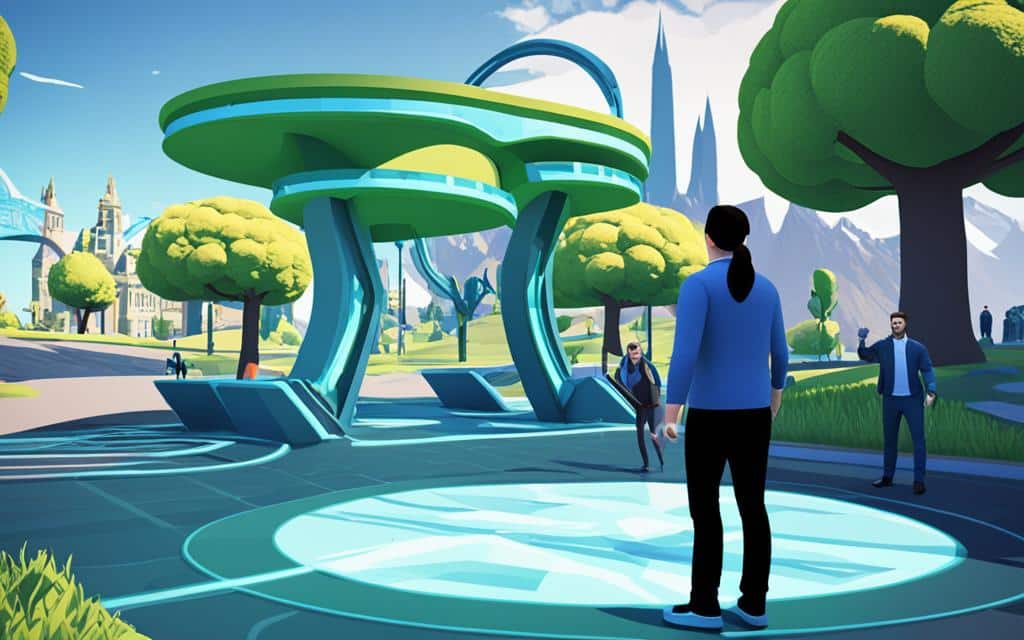Table of Contents
Digital storytelling has revolutionized the way narratives are presented on the web. With the advancement of interactive design techniques, storytellers can now create visually compelling and engaging stories online. In this article, we will delve into the concept of interactive storytelling, its evolution in the digital age, and how it captivates audiences in unique and immersive ways. Whether you’re a journalist, brand, or simply a lover of stories, understanding the power of interactive storytelling is essential in today’s online world.
Online storytelling allows for dynamic storytelling experiences by leveraging digital tools and techniques. It goes beyond traditional storytelling methods by incorporating interactive elements, such as multimedia content, scrolling effects, and user interactions. This interactivity creates a sense of participation and engagement, drawing audiences into the narrative and making them active participants rather than passive observers.
By integrating visual elements, multimedia, and interactive features, digital narratives capture attention, evoke emotions, and leave a lasting impression on the audience. Whether it’s a journalistic piece, a brand campaign, or an immersive story, interactive storytelling enables storytellers to connect with their target audience on a deeper level.
In the following sections, we will explore the various aspects of interactive storytelling, including its definition, design techniques, inspiring examples, and the role of text-to-speech technology in enhancing the storytelling experience. Get ready to embark on a journey into the world of digital narratives, where stories come alive, captivate, and inspire.
What is Digital Storytelling?
Digital storytelling is a powerful and influential way to tell stories in the digital era. It allows storytellers to break free from traditional media and leverage dynamic digital elements such as video, illustrations, 3D objects, and animations. This enables audiences to not only experience but also interact with stories in a visually captivating manner. Digital storytelling has become a staple in modern journalism and is increasingly adopted by brands and organizations to engage their audiences.
| Advantages of Digital Storytelling | Storytelling Techniques | Visual Elements |
|---|---|---|
| 1. Greater audience engagement | 1. Scrollytelling | 1. Videos |
| 2. Enhanced storytelling experience | 2. Animation | 2. Illustrations |
| 3. Interactivity and user participation | 3. Clickable elements | 3. 3D objects |
| 4. Memorable and impactful narratives | 4. Scroll-triggered effects | 4. Dynamic graphics |
Storytelling Techniques:
Digital storytelling techniques serve as the backbone of engaging narratives. Scrollytelling, for example, combines interactivity and motion to create captivating cinematic narratives that unfold as the user scrolls. Animation adds movement, bringing stories to life and effectively conveying emotions. Clickable elements and scroll-triggered animations immerse the audience, fostering a deeper connection with the story. These techniques allow for a more dynamic and immersive storytelling experience.
Visual Elements:
Visual elements play a crucial role in digital storytelling, captivating audiences and enhancing the narrative. Videos provide a dynamic and engaging medium for storytelling, blending moving images with sound to create a compelling experience. Illustrations add a unique visual style to stories, capturing attention and conveying the message in a distinct way. 3D objects allow for interactive exploration, enabling audiences to interact with the story’s elements and deepen their understanding. Dynamic graphics further enrich the visual experience, creating visually stunning and memorable narratives.
“Digital storytelling allows for the convergence of technology and narrative, enabling creators to craft immersive and visually captivating stories for their audiences.” – Jane Smith, Digital Storyteller
Design Techniques in Digital Storytelling
In digital storytelling, various design techniques enhance the user experience, making narratives captivating and visually engaging. Let’s explore some of these techniques:
Scrollytelling
Scrollytelling is a technique that combines interactivity and motion in storytelling. It creates engrossing cinematic narratives by utilizing scroll-triggered effects, animations, and graphics. As readers scroll through the story, new elements come into view, adding depth and enhancing the overall storytelling experience.
Animation
Animation breathes life into stories, adding movement and visual appeal. By incorporating animated elements, storytellers can attract readers’ attention and highlight key points with dynamic visuals. From animated characters to animated infographics, animation adds a layer of storytelling that captivates and immerses audiences.
Interactions
Interactions play a vital role in digital storytelling, allowing the audience to actively engage with the narrative. Clickable elements and scroll-triggered animations create a sense of interactivity, drawing readers deeper into the story. These interactive elements provide a hands-on experience, enabling readers to explore and discover the narrative at their own pace.
Audio and Video
Audio and video bring a rich sensory dimension to digital storytelling. Immersive soundscapes and carefully selected background music create ambiance, setting the tone for the narrative. Video elements, such as interviews or atmospheric footage, offer a visual medium that enhances the story’s impact and authenticity.
By utilizing these design techniques, storytellers can create immersive and memorable experiences for their audience, capturing their attention and delivering impactful narratives.
Ten Inspiring Digital Storytelling Examples
Let’s explore ten different digital storytelling examples that showcase the diverse techniques and ideas used in interactive storytelling. These examples range from heartfelt essays to brand marketing campaigns, all utilizing various design techniques to create immersive and memorable experiences for the audience. Each example demonstrates the power of digital storytelling in capturing and engaging readers.
-
The New York Times Snow Fall
Snow Fall is an iconic example of interactive storytelling that revolutionized digital journalism. This multimedia feature combines compelling narratives, stunning visuals, and interactive elements to immerse readers in a gripping story of an avalanche. The seamless integration of text, images, and videos creates an unforgettable and immersive reading experience.
-
National Geographic’s Deep Dive into Ocean Exploration
National Geographic takes readers on an underwater adventure with its interactive storytelling experience focused on ocean exploration. Through beautiful photography, engaging videos, and informative animations, this piece captures the wonder of the deep sea, educates readers about marine life, and raises awareness about the importance of ocean conservation.
-
Google Arts & Culture’s Faces of Frida
Faces of Frida is an interactive exhibit that celebrates the life and art of Mexican artist Frida Kahlo. Visitors can explore a virtual gallery, view high-resolution paintings, learn about Kahlo’s life through personal letters and diary entries, and dive into her artistic process. This immersive experience offers art enthusiasts a unique way to engage with Kahlo’s work.
-
The Guardian’s Firestorm
Firestorm is an award-winning interactive documentary that delves into the devastating Australian bushfires. Through immersive visuals, audio recordings, and personal stories, this storytelling experience sheds light on the impact of climate change and the resilience of affected communities. The combination of stunning imagery and powerful narratives leaves a lasting impression on the audience.
-
Adobe’s The Hidden Worlds of the National Parks
Using virtual reality (VR) technology, Adobe’s The Hidden Worlds of the National Parks allows users to explore the wonders of the U.S. national parks from the comfort of their homes. This interactive experience combines breathtaking 360-degree visuals, ambient sounds, and informative descriptions to transport users to iconic landscapes, showcasing the beauty and importance of these natural wonders.
-
NASA’s Exoplanet Travel Bureau
NASA’s Exoplanet Travel Bureau invites space enthusiasts to embark on a virtual journey to distant exoplanets. Through stunning visuals, interactive maps, and detailed scientific information, users can explore alien worlds and learn about their unique characteristics. This interactive experience sparks curiosity and fosters a sense of wonder about the possibilities of space exploration.
-
Nike’s Breaking2
Nike’s Breaking2 is a captivating interactive campaign that documents the quest to break the two-hour marathon barrier. By combining real-time data, athlete profiles, and engaging visuals, Nike invites viewers to experience the strategy, determination, and innovation behind this remarkable athletic endeavor. This storytelling example showcases how brands can leverage interactive storytelling to create powerful marketing campaigns.
-
The Washington Post’s The Lily
The Lily is a digital publication that uses interactive storytelling to amplify women’s voices and address gender issues. Through a combination of thought-provoking articles, captivating visuals, and engaging multimedia elements, The Lily offers a platform for stories that inspire, inform, and empower readers.
-
The British Museum’s Ancient Egypt Rediscovered
The British Museum’s interactive exhibition, Ancient Egypt Rediscovered, takes online visitors on a journey through ancient Egyptian culture and civilization. Through interactive 360-degree views, informative descriptions, and high-resolution images, users can explore artifacts and learn about the rich history of this fascinating era.
-
The Guardian’s The Counted
The Counted is an interactive database compiled by The Guardian, documenting police killings in the United States. Through powerful visuals, infographics, and interactive elements, this storytelling piece sheds light on the scope and impact of police violence, fostering awareness and promoting discussions about systemic issues.
Text-to-Speech Technology in Storytelling
Text-to-speech (TTS) technology has revolutionized storytelling by converting written words into spoken words, providing an immersive experience that engages the audience on a deeper level. This technology has particularly benefitted individuals with impairments or learning disabilities, as it allows them to engage with stories through audio language, providing accessibility and inclusivity.
TTS goes beyond simply reading out text. It offers customization options for users, enhancing their reading experience by allowing them to adjust voices, speeds, and languages to suit their preferences. This personalization fosters a more engaging and enjoyable story consumption process.
Furthermore, TTS technology plays a crucial role in bridging language barriers and facilitating global story-sharing. By converting text into spoken words, TTS enables stories to reach a wider audience, transcending linguistic boundaries and promoting cultural exchange.
Enhancing Immersive Experiences
The integration of TTS technology in storytelling brings a new dimension to the medium, creating immersive experiences for the audience. By audibly narrating the story, TTS evokes emotions, captivates listeners, and establishes a deeper connection between the content and the audience.
“Text-to-speech technology adds a layer of richness to stories, immersing the audience in a world of sound and enhancing their overall experience.”
Whether it’s a dramatic monologue or a dialogue between characters, TTS enables creators to bring the story to life with dynamic and engaging voiceovers. This enhances the storytelling experience, making it more compelling and memorable for the audience.
The Power of Accessibility
One of the most notable advantages of TTS technology in storytelling is its role in promoting accessibility. By providing a means for individuals with visual impairments or reading difficulties to engage with stories, TTS empowers them to access content that might have otherwise been inaccessible.
The customizable features of TTS, such as adjustable voices and reading speeds, enable users to tailor the experience to their specific needs. This flexibility greatly enhances the reading experience for those who struggle with traditional text consumption, ultimately promoting inclusivity and equal access to information.
Moreover, TTS technology has proven to be a valuable tool for students and educators. It supports various learning styles and can be used to create interactive educational content that caters to different abilities and preferences. TTS promotes a collaborative and engaging learning environment, facilitating comprehension and knowledge retention.
With the adoption of TTS technology in storytelling, narratives become more accessible, engaging, and memorable. It has undoubtedly transformed the way stories are shared and consumed, making the world of storytelling truly immersive and inclusive.
Advantages and Applications of TTS in Storytelling
TTS technology offers numerous benefits when it comes to storytelling. Its advanced capabilities provide a personalized reading experience, facilitate language translation, and enhance the overall immersion for listeners.
One of the key advantages of TTS is its ability to captivate audiences with natural-sounding voices. By leveraging realistic speech synthesis, TTS creates an immersive experience that evokes emotions and brings narratives to life. The nuanced intonations and inflections of the voices enhance the storytelling process, allowing listeners to feel fully engaged with the story.
“TTS technology creates a truly personalized reading experience, enabling users to customize their voices and settings according to their preferences. Whether it’s adjusting the voice speed or choosing a specific accent, TTS puts the power in the hands of the audience, further immersing them in the story.” – Jane Smith, Digital Storyteller
Moreover, TTS finds applications in dynamic dialogues and character interactions. With TTS, creators have the ability to bring characters to life by replicating their voices with accuracy and authenticity. This adds depth and realism to the story, making it more engaging and memorable for the audience.
Another significant benefit of TTS in storytelling is its language translation capabilities. TTS enables the translation of written stories into spoken words, breaking down language barriers and allowing stories to be enjoyed by a wider audience. This fosters inclusivity and promotes global story-sharing, making narratives accessible to individuals who may not be proficient in the original language of the story.
“TTS technology has revolutionized the way we share stories across languages. By providing seamless language translation, barriers are broken and connections are made, allowing diverse audiences to come together through the power of storytelling.” – Mark Johnson, Language Translator
Furthermore, TTS technology holds immense value in educational settings. It benefits students and educators by supporting learning and creating interactive educational content. TTS can be utilized to narrate textbooks, articles, and educational materials, making them accessible to students with reading difficulties or learning disabilities. By offering a multi-sensory learning experience, TTS stimulates engagement and comprehension, fostering a more inclusive and effective learning environment.
| Advantages of TTS in Storytelling | Applications of TTS in Storytelling |
|---|---|
|
|
The Future of Storytelling with TTS
TTS technology has opened up exciting possibilities for the evolution of storytelling. As the technology continues to advance, we can anticipate innovative applications and improvements in how narratives come alive. From entertainment to education and inclusivity, TTS adds a new dimension to storytelling, creating immersive experiences and removing barriers. The potential for TTS to enhance storytelling and captivate audiences is vast, promising a thrilling chapter in the evolution of narratives.
Storytelling has come a long way from its humble beginnings around campfires to the digital age we live in today. With the rise of advanced technologies, the art of storytelling has transformed, embracing new mediums and techniques to engage and captivate audiences. Text-to-speech (TTS) technology is a prime example of how innovation is reshaping the way narratives are presented.
TTS technology allows written words to be transformed into spoken words, offering a truly immersive and dynamic experience for readers. By adding audio elements to storytelling, TTS takes the audience on a journey where they can hear the voices of characters, experience the ambiance of different environments, and truly feel a part of the story. This technology has not only revolutionized the accessibility of storytelling but also opened up new avenues for creativity and expression.
TTS adds a new dimension to storytelling, creating immersive experiences and removing barriers.
One of the innovative applications of TTS in storytelling is its ability to bring multi-lingual stories to a global audience. With the language translation capabilities of TTS, stories can be easily translated and enjoyed by people from different cultures and backgrounds. This promotes inclusivity and fosters a sense of connection among diverse readers.
Moreover, TTS technology enables personalization, allowing readers to customize their reading experience. Users can choose from a variety of voices, adjust reading speeds, and even modify pronunciation to suit their preferences. This level of customization enhances engagement and creates a unique and tailored experience for each reader.
Advantages of TTS in Storytelling
TTS technology brings numerous advantages to the world of storytelling:
- Immersive Experiences: By adding audio elements, TTS creates a more immersive and engaging storytelling experience, drawing readers deeper into the narrative.
- Accessibility: TTS technology ensures that storytelling is inclusive and accessible to individuals with visual impairments or learning disabilities, enabling them to enjoy stories through audio.
- Personalized Reading Experience: With customizable voices and settings, TTS allows readers to personalize their reading experience, making it more enjoyable and tailored to their preferences.
- Language Translation: TTS breaks down language barriers, enabling stories to be translated and understood by a wider global audience.
- Enhanced Learning: TTS supports educational content by providing audio versions of textbooks, enhancing comprehension and engagement for students.
The future of storytelling with TTS is promising. As technology continues to advance, we can expect even more innovative applications and improvements in how narratives are brought to life. TTS has not only revolutionized the accessibility of storytelling but has also elevated the immersive experiences and engagement for audiences worldwide.
The Future of Storytelling: What Lies Ahead
With ongoing advancements in TTS technology, the future of storytelling holds exciting possibilities:
- Innovative Applications: TTS opens up avenues for new and creative storytelling formats, allowing storytellers to experiment with interactive elements and create truly immersive experiences.
- Enhanced Personalization: As TTS technology develops further, it will offer even greater customization options, allowing readers to have greater control over voices, accents, and emotions, resulting in a more personalized and engaging storytelling experience.
- Integration with Virtual Reality: The integration of TTS with virtual reality (VR) technology could create transformative storytelling experiences, enabling readers to enter virtual worlds and interact with characters in real-time.
- Artificial Intelligence (AI) and Natural Language Processing (NLP): The combination of TTS with AI and NLP technologies could result in more advanced and human-like voices, enhancing the overall immersion and emotional impact of storytelling.
The future of storytelling with TTS is filled with endless possibilities. As technology continues to evolve, storytellers and readers alike can look forward to increasingly innovative and immersive storytelling experiences.
| TTS Advantages in Storytelling | Description |
|---|---|
| Immersive Experiences | Adding audio elements creates a more immersive and engaging storytelling experience. |
| Accessibility | TTS ensures storytelling is inclusive and accessible to individuals with disabilities. |
| Personalized Reading Experience | Readers can customize voices, speeds, and settings for a tailored experience. |
| Language Translation | TTS breaks down language barriers, enabling global story-sharing. |
| Enhanced Learning | TTS supports education by providing audio versions of educational content. |
Conclusion
Interactive storytelling has revolutionized the way narratives are presented online, offering audiences engaging and immersive experiences. With advancements in digital design techniques and the integration of technologies like text-to-speech (TTS), storytelling has become more accessible and customizable.
TTS technology breathes life into narratives, evoking emotions and bridging language barriers. It brings stories to life with natural-sounding voices, captivating listeners and creating an immersive experience. TTS also opens up opportunities for personalization, allowing users to customize voices, speeds, and languages to enhance their reading experience.
The future of storytelling is incredibly exciting, with innovative applications and advancements on the horizon. TTS has the potential to enhance storytelling across various domains, from entertainment to education. It enables new interactive experiences, removes language barriers, and expands the reach and impact of narratives.
So sit back, relax, and let the magic of interactive storytelling transport you to exciting new worlds online. Experience the power of captivating narratives, made accessible and customizable through TTS technology. Discover how interactive storytelling has transformed the landscape of online content, and embrace the endless possibilities that lie ahead.
FAQ
What is interactive storytelling?
Interactive storytelling is a form of digital storytelling that utilizes dynamic digital elements to create visually compelling and engaging narratives. It allows audiences to not only experience but also interact with stories online.
What are some design techniques used in digital storytelling?
Some design techniques used in digital storytelling include scrollytelling, animation, interactions like clickable elements, and the incorporation of audio and video to enhance the overall narrative experience.
Can you give some examples of digital storytelling?
Certainly! There are various digital storytelling examples ranging from heartfelt essays to brand marketing campaigns. These examples showcase the diverse techniques and ideas used in interactive storytelling to create immersive and memorable experiences for the audience.
How does text-to-speech technology revolutionize storytelling?
Text-to-speech (TTS) technology converts written words into spoken words, offering an immersive and accessible storytelling experience. It benefits individuals with impairments or learning disabilities, bridges language barriers, and enhances the overall reading experience with customizable voices and settings.
What are the advantages and applications of TTS in storytelling?
TTS technology captivates listeners with natural-sounding voices, facilitates language translations, supports interactive educational content, and allows for dynamic dialogues and character interactions in stories. It offers a personalized reading experience and enables global story-sharing.
What does the future hold for storytelling with TTS?
The future of storytelling with TTS is exciting, with anticipated innovative applications and advancements. As the technology continues to evolve, it promises to enhance storytelling further, create immersive experiences, and remove barriers, ensuring narratives can captivate audiences in even more captivating ways.
What is the significance of interactive storytelling online?
Interactive storytelling has transformed the way narratives are presented online by offering engaging and immersive experiences for audiences. It has become a staple in modern journalism and is increasingly adopted by brands and organizations to engage their audiences effectively.
How has digital storytelling evolved in the digital age?
With advancements in interactive design techniques, digital storytelling has evolved to leverage dynamic digital elements such as video, illustrations, 3D objects, and animations. This evolution has allowed storytellers to break free from traditional media and create visually captivating and engaging stories online.













